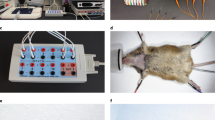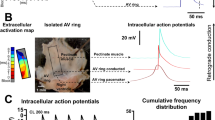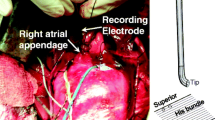Abstract
Transgenic mice are increasingly being utilized for understanding cardiac electrophysiologic abnormalities. However, little is known about the normal atrioventricular nodal and infraHisian physiology in the mouse because of the prior inability to record a His-bundle deflection. We present the first comprehensive examination of the murine atrioventricular nodal and His-Purkinje systems employing His-bundle recordings. Normal, healthy, male C57BL/6J mice (n = 48) underwent an in vivo electrophysiology study using a 2 F octapolar electrode catheter. Effective refractory periods were determined during premature atrial and ventricular stimulation. The PR interval measured 44 ± 6 ms with a mean sinus cycle length of 185 ± 42 ms. Baseline AH intervals were 36 ± 5 ms and HV intervals were 10 ± 2 ms. At a pacing cycle length of 140 ms the atrioventricular nodal effective refractory period (AVNERP) and atrial effective refractory period (AERP) were 86 ± 19 ms and 57 ± 17 ms, respectively. The mean AV Wenckebach and 2:1 paced cycle length were 103 ± 14 ms and 84 ± 13 ms, respectively. Premature atrial stimulation curves were asymptotic without discontinuity. A subset of nine mice was studied after administration of isoproterenol. The sinus cycle length, AVNERP and AERP decreased significantly from baseline measurements. This method establishes a practical and feasible technique to record in vivo His-bundle electrograms in the mouse to assess atrioventricular nodal and infraHisian physiology. Use of this model will allow for the examination of abnormalities of atrioventricular nodal and infraHisian conduction in transgenic murine models.
Similar content being viewed by others
References
Chien KR. Cardiac muscle diseases in genetically engineered mice: evolution of molecular physiology. Am J Physiol 1995;269:H755–H766.
Christensen G, Wang Y, Chien KR. Physiological assessment of complex cardiac phenotypes in genetically engineered mice. Am J Physiol 1997;272:H2513–H2524.
Geisterfer-Lowrance A, Christe M, Conner D, et al. A mouse model of familial hypertrophic cardiomyopathy. Science 1996;272:731–734.
Hein L, Barsh GS, Pratt RE, et al. Behavioral and cardiovascular effects of disrupting the angiotensin II type-2 receptor in mice. Nature 1995;377:744–747.
Milano CA, Allen LF, Rockman HA, et al. Enhanced myocardial function in transgenic mice overexpressing the β2-adrenergic receptor. Science 1994;264:582–585.
Berul CI, ME Christe ME, Aronovitz MJ, et al. Electrophysiological abnormalities and arrhythmias in αMHC mutant familial hypertrophic cardiomyopathy mice. J Clin Invest 1997;99:570–576.
Berul CI, Aronovitz MJ, Wang PJ, et al. In vivo cardiac electrophysiology studies in the mouse. Circulation 1996;94:2641–2648.
Thomas SA, Schuessler RB, Berul CI, et al. Disparate effects of deficient expression of connexin 43 on atrial and ventricular conduction. Circulation 1998;197:686–691.
Guerrero PA, Schuessler RB, Davis LM, et al. Slow ventricular conduction in mice heterozygous for a connexin 43 null mutation. J Clin Invest 1997;99:1991–1998.
James JF, Hewett TE, Robbins J. Cardiac physiology in transgenic mice. Circ Res 1998;82:407–415.
Castellanos A Jr, Castillo C, Agha A. Contribution of His bundle recording to the understanding of clinical arrhythmias. Am J Cardiol 1971;28:499–508.
Josephson ME, ed. Clinical Cardiac Electrophysiology: Techniques and Interpretations, 2nd ed. Malvern, PA: Lea & Febiger, 1993, 22–70.
Lev M, Thaemert JC. The conduction system of the mouse heart. Acat Anat 1973;85:342–352.
Viragh S, Challice CE. The development of the conduction system in the mouse embryo heart II: Histogenesis of the atrioventricular node and bundle. Developmental Biology 1977;56:397–411.
Kupersmith J, Krongrad E, Waldo A. Conduction intervals and conduction velocities in human cardiac conduction system. Circulation 1973;47:776–785.
Lombard EA. Electrocardiograms of small mammals. Am J Physiol 1952;171:189–193.
Richards AG, Simonson E, Visscher MB: Electrocardiogram and phonocardiogram of adult and newborn mice in normal conditions and under effect of cooling, hypoxia, and potassium. Am J Physiol 1953;174:293–298.
Author information
Authors and Affiliations
Rights and permissions
About this article
Cite this article
VanderBrink, B.A., Link, M.S., Aronovitz, M.J. et al. Assessment of Atrioventricular Nodal Physiology in the Mouse. J Interv Card Electrophysiol 3, 207–212 (1999). https://doi.org/10.1023/A:1009842105146
Issue Date:
DOI: https://doi.org/10.1023/A:1009842105146




